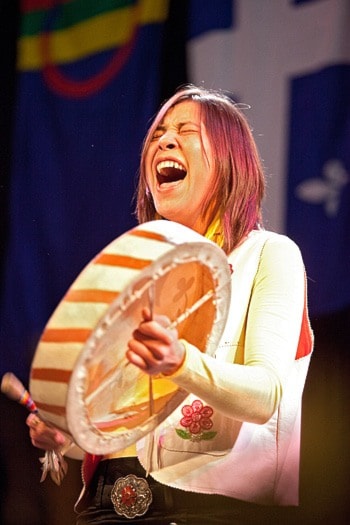Gary Bailie was beaming on Wednesday night as people lined up outside the new Kwanlin Dun Cultural Centre on the banks of the Yukon River in downtown Whitehorse.
“This night is like icing on the cake,” said Bailie, the centre’s operations manager and a driving force behind its construction.
This week the centre opened its doors for the Arctic Winter Games. It’s the venue for the Dene Games as well as this evening’s cultural performances.
Bailie is flagged down by the volunteers posted at the archway of the longhouse inside: they’ve already let 400 people through the doors and that’s capacity.
Problem is more people are pushing their way in from the cold outside and filling up the lobby.
Bailie pauses, his hands full of cables, and looks around at the corralled people. Then he looks into the large, cedar-lined longhouse.
All of the seats are full. All of the round tables, designated for elders are also full.
Every tall, circular table, designed for those who’d prefer to stand, is surrounded by people chatting and looking around.
Bailie looks back at the volunteers at the door.
“Just let them in,” he said, with a happy sigh before rushing back to tend to the sound system.
Back inside, hidden behind stacks of monitors and sound equipment, Bailie stands almost in a trance, listening to the sound of the drums and chants reverberate around the room.
“People are here enjoying themselves and bringing life to the centre. It is a big, beautiful building, but we needed people to make it come alive,” said Bailie.
“That’s what’s going on tonight. We’re breathing some life into it, with the Dene Games, and especially with this, because we’re just celebrating and having fun.”
The cultural night was arranged thanks to the quick thinking of Dene Games co-chair and coach Shirley Dawson.
When she noticed there was no entertainment scheduled for Wednesday night, she started working on filling the evening with a cultural event at the new cultural centre.
“Tonight is a celebration about us,” said Dawson. “For me, when I became a part of the Arctic Winter Games team, it was about First Nation inclusion. Whenever I saw an opportunity for Kwanlin Dun to be involved, I just jumped on it.”
Although the centre’s official grand opening is slated for June 21, National Aboriginal Day, Dawson pushed for a “sneak peek” before an international audience during the Games.
“This building is the physical representation of the role the Kwanlin Dun First Nation aspires to play in Whitehorse and the Yukon,” Kwanlin Dun Chief Rick O’Brien told the crowd.
“It represents how we want to work with others to create a welcoming place for visitors and all members of the community.”
Former chief Mike Smith, who was in power when work began on the centre, was also in attendance.
“The number one point that we really wanted to make with this cultural centre is that we can create a place for our children, where they can be proud,” said Smith.
They also paid tribute to former chief Johnny Smith, who died last year, by playing a recording of him singing a song about the importance of the riverbed.
“They tried to keep us from the Yukon River,” said Smith’s daughter, Judy Gingell, who now sits on Kwanlin Dun’s council.
“But here we are, back right where we started.”
Phil Gatensby, who is spending the week behind the centre in a wall tent, tending the Games’ sacred fire, said the building is a testament to the strength of First Nations.
“Through all the adversity, First Nations people are not only still here, but so willing to share our culture,” he said.
The sacred fire is a first for the international games. With sweetgrass and tobacco on hand for smudging, it serves as a place for sharing cultural traditions.
Hundreds of people have come by to see the fire, said Gatensby, as he sits inside the tent that smells of the balsam boughs covering the floor.
“It’s been incredible,” he said. “We’ve had opportunity to share some of the sacred teachings with people from Greenland and Sami people, and actually everybody. All day long this tent is filled with people socializing, telling stories. It’s an incredible thing.”
Those people have also shared their own traditions and teachings, he said.
“We’re the same people. That’s what stands out for me. We’re bound by the common thread of simply being human. It’s our humanity that brings us together.
“A lot of stuff we talk about are changing times and how much the indigenous people hold something incredibly special. That really is the relationship with the land, the connection to the land. And the condition of the world we live in now is because people have forgotten how they’re connected.
“Part of this ceremony and part of sharing in this tent is really about that - helping people to remember who they are.”
Contact Roxanne Stasyszyn at
roxannes@yukon-news.com
